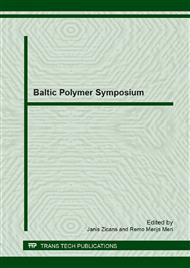[1]
R. Auras, L. Lim, S. Selke, H. Tsuji, POLY(LACTIC ACID): Synthesis, Structures, Properties, Processing, and Applications, John Wiley & Sons, Hoboken, New Jersey, 2010.
DOI: 10.1002/9780470649848
Google Scholar
[2]
R. Liao, B. Yang, W. Yu, C. Zhou, Isothermal Cold Crystallization Kinetics of Polylactide/Nucleating Agents. J. Appl. Polym. Sci., 104 (2007) 310-317.
DOI: 10.1002/app.25733
Google Scholar
[3]
C. Baillie. Green Composites: Polymer Composites and the Environment, Woodhead Publishing Ltd, 2004.
Google Scholar
[4]
L. Petersson, I. Kvien, K. Oksman, Structure and thermal properties of poly(lactic acid)/cellulose whiskers nanocomposite materials, Compos. Sci. Technol., 67 (2007) 2535-2544.
DOI: 10.1016/j.compscitech.2006.12.012
Google Scholar
[5]
L. Yu, H. Liu, K. Dean, L. Chen, Cold Crystallization and Postmelting Crystallization of PLA Plasticized by Compressed Carbon Dioxide, J. Polym. Sci. Polym. Phys., 46 (2008) 2630-2636.
DOI: 10.1002/polb.21599
Google Scholar
[6]
A.P. Mathew, K. Oksman, M. Sain, The Effect of Morphology and Chemical Characteristics of Cellulose Reinforcements on the Crystallinity
of Polylactic Acid, J. Appl. Polym. Sci., 101 (2006) 300-310.
DOI: 10.1002/app.23346
Google Scholar
[7]
Y. He, Y, Xu, J. Wei, Z. Fan, S. Li, Unique crystallization behavior of poly(L-lactide) / poly(D-lactide) stereocomplex depending on initial melt states, Polymer, 49 (2008) 5670-5675.
DOI: 10.1016/j.polymer.2008.10.028
Google Scholar
[8]
M. Day, A. V. Nawaby, X. Liao, A DSC Study of the Crystallization Behaviour of Polylactic acid and its Nanocomposites, J. Therm. Anal. Calorim., 86 (2006) 623-629.
DOI: 10.1007/s10973-006-7717-9
Google Scholar
[9]
J. George, M.S. Sreekala, S. Thomas, A Review on Interface Modification and Characterization of Natural Fiber Reinforced Plastic Composites, Polym. Eng. Sci., 41 (2001) 1471-1485.
DOI: 10.1002/pen.10846
Google Scholar
[10]
L. Suryanegara, A.N. Nakagaito, H. Yano, Thermo-mechanical properties of microfibrillated cellulose-reinforced partially crystallized PLA composite, Cellulose, 2010, (2010) 771-778.
DOI: 10.1007/s10570-010-9419-5
Google Scholar
[11]
T.G. Mezger, The Rheology Handbook, second ed., Vincentz Network, Hannover, 2006.
Google Scholar
[12]
S. Barthel, T. Heinze, Acylation and carbanilation of cellulose in ionic liquids, Green Chem, 8 (2006) 301-306.
DOI: 10.1039/b513157j
Google Scholar


